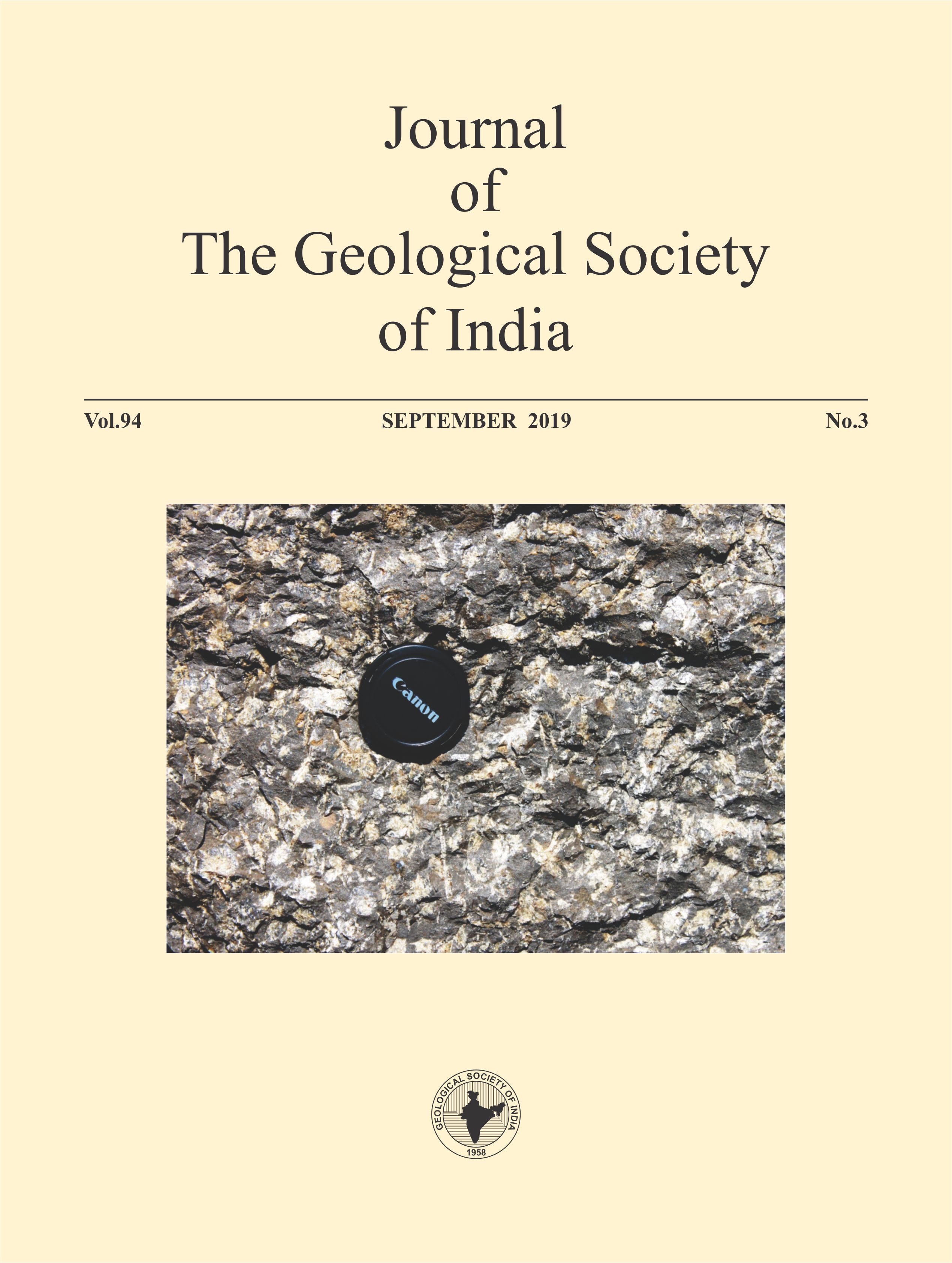Development and Management of Base Flow of a Sand-dominated Alluvial Aquifer of a Large Ephemeral River for Drinking Water Supply in Semi-Arid and Fluoride Affected Areas: Example of the River Mayurakshi, Birbhum District, West Bengal, India
DOI:
https://doi.org/10.1007/s12594-019-1304-8Keywords:
No Keywords.Abstract
Semi-arid tropical regions in India and elsewhere face major challenges in the management of public water supply for drinking purpose. In such regions knowledge on base flow availability in major rivers is important in development of water management strategies and estimation of small to medium water supplies especially for semi-arid conditions where groundwater is contaminated with fluoride at variable depths.
This study focuses on identification, exploitation and utilization of the unexploited base flow of the river Mayurakshi between Md. Bazar in the west and Sainthia in the east in Birbhum district, West Bengal, by understanding the subsurface hydrogeology of the river as well as a proper knowledge of the water budget, water resources in storage, and water quality.
Exploratory drilling on the river bed revealed two aquifer settings: unconfined in the west, and semi-confined in the east. Water level is shallow occurring within 2 m below ground level. The sands of the unconfined aquifer are mostly coarse and that of the semi-confined aquifer are medium to coarse. The transmissivity values reveal that the potentiality of the aquifer in the western stretch of the river is higher than that of the eastern stretch. Water supply systems that can be constructed below the river are bedmounted infiltration gallery and collector well with radials. Water quality does not exceed the permissible limit of Indian Drinking Water Standard except for manganese, iron and colliform bacteria. Therefore, the water needs to be treated for these parameters before supplying to the communities for drinking purpose.
Downloads
Metrics
Issue
Section
Downloads
Published
How to Cite
References
Ali M. (2003) Review of drilling and tubewell technology for groundwater irrigation. In: Rahman A.A., Ravenscroft P., (Eds.), Groundwater resources and development in Bangladesh-background to be arsenic crisis, agricultural potential and the environment, Dhaka: Bangladesh Centre for Advanced Studies, University Press Ltd.
APHA (American Public Health Association) (1995) Standard Methods for the Examination of Water and Wastewater, 19th edition, American Public Health Association, American Water Works Association, and Water Pollution Control Federation: Washington, DC.
Ball, P. and Danert, K. (1999) Hand and Sludging: a Report from Northwest Bengal. Report of DFID KAR Project R7126 "Private Sector Participation in Low Cost Water Well Drilling", Cranfield University.
BBS/UNICEF. (2011) Bangladesh National Drinking Water Quality Survey 2009. Bangladesh Bureau of Statistics and UNICEF, Dhaka.
BIS 10500. (2012) Indian Standard Drinking Water - Specification (Second Revision). Bureau of Indian Standards, New Delhi, pp.1-11.
CGWB (Central Ground Water Board) and SWID (State Water Investigation Directorate). (2011) Report on the dynamic ground water resources of West Bengal as on 31.03.2009, Technical report series ‘B' No. 234, 1-244.
Cooper, H.H. and Jacob, C.E. (1946) A generalized graphical method for evaluating formation constants and summarizing well field history. Amer. Geophys. Union Trans., v.27, pp.526-534.
Delin, G.N., Healy, R.W., Lorenz, D.L. and Nimmo, J.R. (2007) Comparison of local to regional scale estimates of ground-water recharge in Minnesota, USA. Jour. Hydrol., v.334, pp.231–249.
Driscoll, F.G. (1986) Groundwater and Wells. 2nd ed. Johnson Division, St. Paul, MN.
Folk, R.L. (1986) Petrology of Sedimentary Rocks: Austin, University of Texas Publication, 170p.
Freeze, R.A. and Cherry, J.A. (1979) Groundwater. Prentice Hall Inc., Englewood Cliffs, N.J., 604p.
GSI (Geological Survey of India) (2001) District Resource Map of Birbhum, West Bengal. www.portal.gsi.gov.in (accessed on 25.02. 2012).
Mathias, S.A. and Wheater, H.S. (2010). Groundwater modeling in arid and semi-arid areas: an introduction. In: Wheater H.S., Mathias S.A., Li, X. (Eds.), Groundwater modeling in arid and semi-arid areas: Cambridge University Press.
McArthur, J.M., Sikdar, P.K., Hoque, M.A. and Ghosal, U. (2012) Waste water impacts on groundwater: Cl/Br ratios and implications for arsenic pollution of groundwater in the Bengal Basin and Red River Basin, Vietnam. Science of the Total Environment, v.437, pp.390-402.
McMahon, T.A., & Mein, R.G. (1986) River and Reservoir Yield. Water Resources Publication, Littleton, CO, 368p.
Nickson, R., McArthur, J.M., Ravenscroft, P., Burges, W.G., & Ahmed, K.M. (2000) Mechanism of arsenic release to groundwater, Bangladesh and West Bengal. Appld. Geochem., v.15, pp.403-413.
Reay, W.G., Gallagher, D.L. and Simmons Jr., G.M. (1992) Groundwater discharge and its impact on surface water quality in a Chesapeake Bay inlet. Water Resources Bull., v.28(6), pp.1121–1133.
Raghunath, H.M. (2007) Ground Water. 3rd ed. New Age International (P) Limited, New Delhi.
Santhi, C., Allen P.M., Muttiah, R.S., Arnold, J.G. and Tuppad, P. (2008). Regional estimation of base flow for the conterminous United States by hydrologic landscape regions. Jour. Hydrol., v.351, pp.139-153.
Sengupta, S., McArthur, J.M., Sarkar, A.K., Leng, M., Ravenscroft, P., & Howarth, R.J., et al. (2008) Do ponds cause arsenic-pollution of groundwater in the Bengal Basin? An answer from West Bengal. Environment Science and Technology, v.42, pp.5156-64.
Sinha Ray, S.P. (2008) Report on Studies of High Fluoride Groundwater in parts of Birbhum district with a view to find out cause of its mobilization and develop strategies for safe drinking water supply. Centre for Ground Water Studies. Kolkata, August 2008.
Stuckey, M.H. (2006) Low flow, base flow, and mean flow regression equations for Pennsylvania streams. US Geological Survey Scientific Investigations Report, 2006-5130.
Stumm, W. and Morgan, J.J. (1996) Aquatic Chemistry. Wiley-Interscience: New York.
Theis, C.V. (1935) The relation between the lowering of the piezometric surface and the rate and duration of discharge of well using groundwater storage. Amer. Geophys. Union Trans., v.16, pp.519-524.

 P. K. Sikdar
P. K. Sikdar






